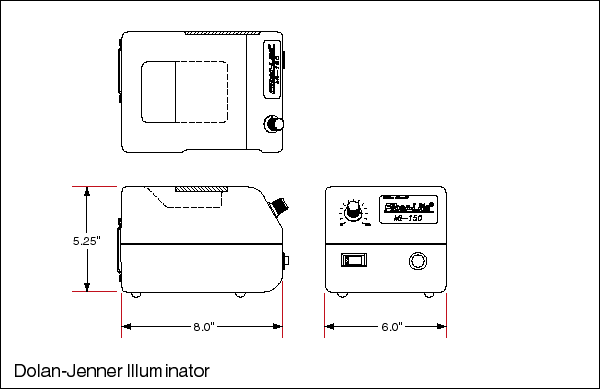
| Voltage (V) | Compare | Stock Number | Price | Buy | |
|---|---|---|---|---|---|
| 230.00 | #59-236 | ₹56,637 Request Quote |
|
Dolan-Jenner Fiber-Lite Mi-150 Series Fiber Optic Illuminators are designed with a 150W EKE bulb that has a typical lifetime of 1,000-10,000 hours depending on intensity. These illuminators have a low-profile top handle and side doors for easy lamp changes. Dolan-Jenner Fiber-Lite Mi-150 Series Fiber Optic Illuminators also feature an on/off rocker switch and an adjustment knob for intensity control. These illuminators are ideal for microscopy and spectroscopy applications. Dolan Jenner SX Fiber Optic adapters needed to mate with fiber optic light guides. Replacement Bulb sold separately.
| Title | Compare | Stock Number | Price | Buy | |
|---|---|---|---|---|---|
| 150W EKE-X, Replacment Bulb | #59-477 | ₹3,045 Request Quote |
|
||
| 2.37" ID, Fiber Optic Ring Light Guide | #58-839 | ₹88,218 Request Quote |
|
||
| 1.55" ID, Fiber Optic Ring Light Guide | #54-174 | ₹58,986 Request Quote |
|
||
| 150W EKE, Replacement Bulb | #39-606 | ₹2,610 Request Quote |
|
||
| 0.191" ID Fiber Optic Adapter MX-5 | #66-904 | ₹3,306 Request Quote |
|
||
| 0.316" ID Fiber Optic Adapter MX-6 | #66-905 | ₹3,306 Request Quote |
|
||
| 0.565" ID Fiber Optic Adapter MX-10 | #66-908 | ₹3,306 Request Quote |
|
||
| 0.629" ID Fiber Optic Adapter MX-11 | #66-909 | ₹3,306 Request Quote |
|
||
| 0.191" ID, Fiber Optic Adapter SX-5 | #38-943 | ₹3,915 Request Quote |
|
||
| 0.316" ID, Fiber Optic Adapter SX-6 | #38-944 | ₹3,915 Request Quote |
|
||
| 0.565" ID, Fiber Optic Adapter SX-10 | #38-946 | ₹3,915 Request Quote |
|
||
| 0.629" ID, Fiber Optic Adapter SX-11 | #38-947 | ₹3,915 Request Quote |
|

1-800-363-1992
or view regional numbers
QUOTE TOOL
enter stock numbers to begin
Copyright 2025, Edmund Optics India Private Limited, #267, Greystone Building, Second Floor, 6th Cross Rd, Binnamangala, Stage 1, Indiranagar, Bengaluru, Karnataka, India 560038
California Consumer Privacy Acts (CCPA): Do Not Sell or Share My Personal Information
California Transparency in Supply Chains Act